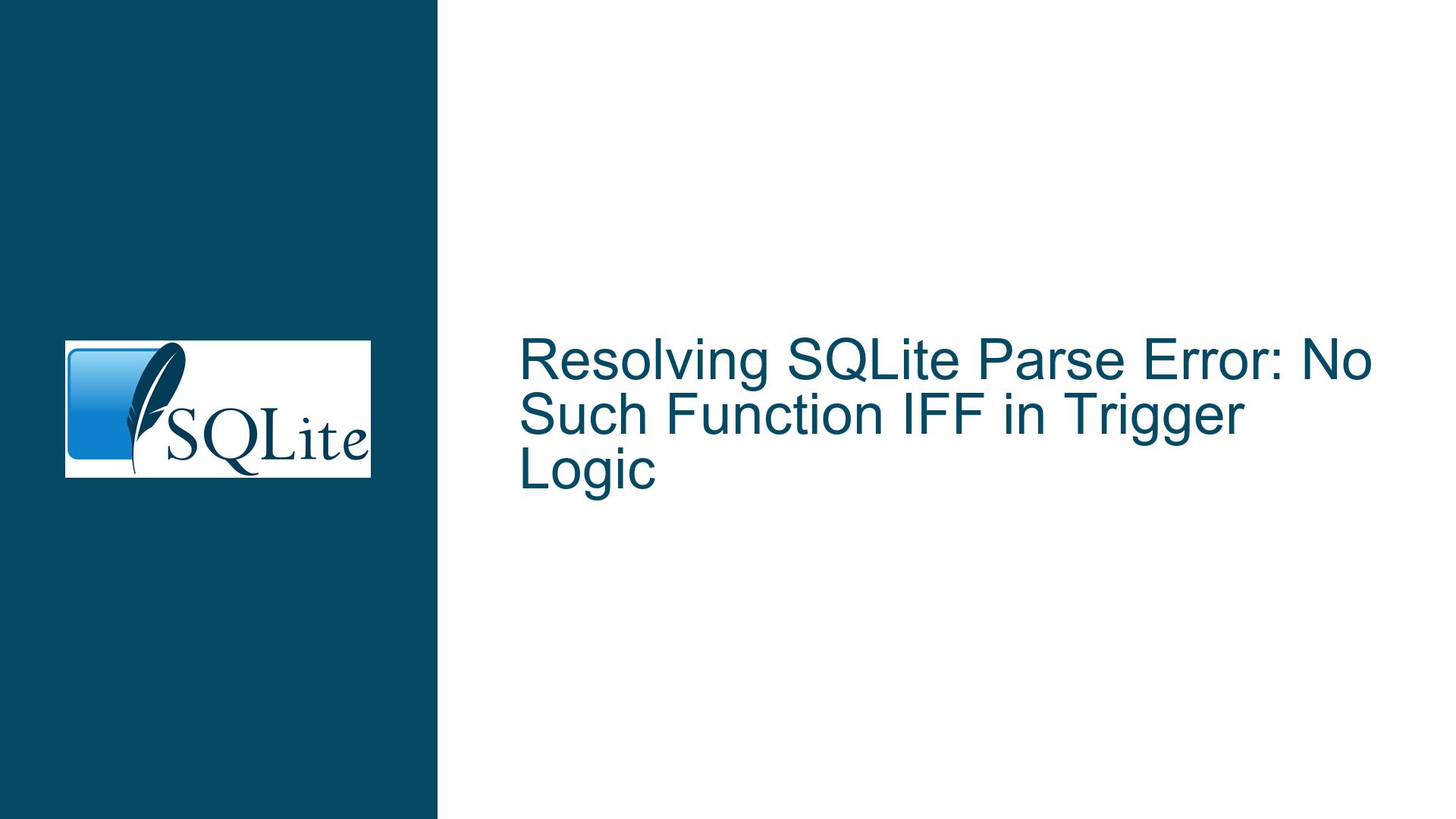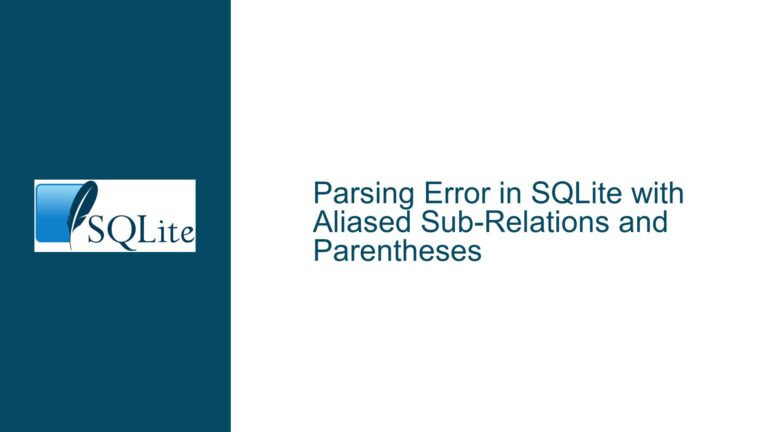Resolving SQLite Parse Error: No Such Function IFF in Trigger Logic
Understanding the Parse Error: No Such Function IFF in SQLite Triggers
The core issue revolves around a parse error encountered when attempting to use the IFF function within a trigger in SQLite. The error message explicitly states that the function IFF does not exist. This error occurs in the context of a trigger designed to update a counter in a table named HIS_COUNTER whenever a new password is inserted into a HISTORY table. The trigger logic is intended to increment a counter for a specific keyword, but the use of the IFF function is causing the SQLite parser to fail.
The trigger in question is defined as follows:
CREATE TRIGGER IF NOT EXISTS HIS_COUNTER_UPDATE AFTER INSERT ON HISTORY
WHEN (SELECT entry_counter FROM HIS_COUNTER WHERE keyword == NEW.keyword) < 10
BEGIN
INSERT OR REPLACE INTO HIS_COUNTER
(keyword, entry_counter)
VALUES (NEW.keyword, 1)
ON CONFLICT DO
UPDATE SET
entry_counter=(
IFF((SELECT entry_counter FROM HIS_COUNTER WHERE keyword == NEW.keyword) < 10, (SELECT entry_counter FROM HIS_COUNTER WHERE keyword == NEW.keyword) + 1, 1)
);
END;
The error arises specifically from the line where the IFF function is used to conditionally update the entry_counter field. The function IFF is not a built-in function in SQLite, which is why the parser fails to recognize it. This leads to the immediate question: why is IFF being used, and what is the correct way to implement this logic in SQLite?
The Misuse of IFF and SQLite’s Function Naming Conventions
The root cause of the issue lies in the incorrect usage of the IFF function. The user intended to use the IIF function, which is a built-in function in SQLite. The IIF function is a shorthand for a conditional expression, similar to the ternary operator in many programming languages. It takes three arguments: a condition, a value to return if the condition is true, and a value to return if the condition is false. The correct syntax for IIF is:
IIF(condition, value_if_true, value_if_false)
In the trigger logic, the user mistakenly used IFF (with three ‘F’s) instead of IIF (with two ‘I’s and one ‘F’). This typo is the direct cause of the parse error. SQLite does not have a function named IFF, and the parser is unable to resolve the function name, resulting in the error.
Additionally, there is some confusion regarding the availability of the IIF function in different versions of SQLite. The user mentions upgrading to version 3.48 to use IIF, but this is unnecessary. The IIF function has been available in SQLite since version 3.32.0, which was released in May 2020. Therefore, the issue is not related to the SQLite version but rather to the incorrect spelling of the function name.
Another point of confusion is the suggestion to load the function with a setting in $HOME/.sqliterc. This is not required for IIF, as it is a built-in function and does not need to be defined or loaded manually. The IIF function is part of SQLite’s core functions and is available by default in all connections.
Correcting the Trigger Logic and Best Practices for Conditional Updates
To resolve the issue, the trigger logic must be corrected to use the IIF function instead of IFF. The corrected trigger definition is as follows:
CREATE TRIGGER IF NOT EXISTS HIS_COUNTER_UPDATE AFTER INSERT ON HISTORY
WHEN (SELECT entry_counter FROM HIS_COUNTER WHERE keyword == NEW.keyword) < 10
BEGIN
INSERT OR REPLACE INTO HIS_COUNTER
(keyword, entry_counter)
VALUES (NEW.keyword, 1)
ON CONFLICT DO
UPDATE SET
entry_counter=(
IIF((SELECT entry_counter FROM HIS_COUNTER WHERE keyword == NEW.keyword) < 10, (SELECT entry_counter FROM HIS_COUNTER WHERE keyword == NEW.keyword) + 1, 1)
);
END;
This corrected trigger uses the IIF function to conditionally update the entry_counter field. If the current value of entry_counter for the given keyword is less than 10, it increments the counter by 1. Otherwise, it sets the counter to 1.
However, there are additional improvements that can be made to the trigger logic to enhance its efficiency and readability. One such improvement is the use of the excluded keyword in the UPDATE clause of the INSERT OR REPLACE statement. The excluded keyword refers to the row that was attempted to be inserted, which is particularly useful in conflict resolution scenarios. The improved trigger definition is:
CREATE TRIGGER IF NOT EXISTS HIS_COUNTER_UPDATE AFTER INSERT ON HISTORY
WHEN (SELECT entry_counter FROM HIS_COUNTER WHERE keyword == NEW.keyword) < 10
BEGIN
INSERT OR REPLACE INTO HIS_COUNTER
(keyword, entry_counter)
VALUES (NEW.keyword, 1)
ON CONFLICT(keyword) DO
UPDATE SET
entry_counter=IIF(excluded.entry_counter < 10, excluded.entry_counter + 1, 1);
END;
In this version, the excluded.entry_counter is used directly in the IIF function, eliminating the need for a subquery to retrieve the current value of entry_counter. This makes the trigger more efficient and easier to understand.
Another consideration is the use of the CASE expression as an alternative to IIF. The CASE expression is more versatile and can handle multiple conditions, making it a better choice for complex logic. The trigger can be rewritten using CASE as follows:
CREATE TRIGGER IF NOT EXISTS HIS_COUNTER_UPDATE AFTER INSERT ON HISTORY
WHEN (SELECT entry_counter FROM HIS_COUNTER WHERE keyword == NEW.keyword) < 10
BEGIN
INSERT OR REPLACE INTO HIS_COUNTER
(keyword, entry_counter)
VALUES (NEW.keyword, 1)
ON CONFLICT(keyword) DO
UPDATE SET
entry_counter=CASE
WHEN excluded.entry_counter < 10 THEN excluded.entry_counter + 1
ELSE 1
END;
END;
This version of the trigger uses a CASE expression to achieve the same result as the IIF function. The CASE expression is more readable and can be extended to handle additional conditions if needed.
Conclusion and Final Recommendations
The parse error caused by the incorrect use of the IFF function in the trigger logic is a common issue that can be easily resolved by using the correct function name, IIF. Additionally, the trigger logic can be optimized by leveraging the excluded keyword and considering the use of the CASE expression for more complex conditional logic. By following these best practices, the trigger will function as intended, ensuring that the HIS_COUNTER table is updated correctly whenever a new password is inserted into the HISTORY table.
To summarize, the key takeaways are:
- Always use the correct function name (
IIF) for conditional expressions in SQLite. - Consider using the
excludedkeyword in conflict resolution scenarios to improve efficiency. - Use the
CASEexpression for more complex conditional logic, as it is more versatile and readable.
By adhering to these guidelines, you can avoid common pitfalls and ensure that your SQLite triggers and queries are both efficient and maintainable.






